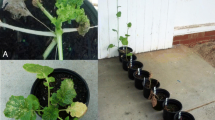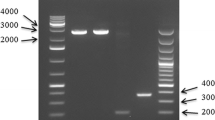Abstract
When screening the genusNicotiana for sensitive and differential hosts for a group of mechanically transmissible plant viruses with narrow host ranges, development of systemic symptoms was alsmost exclusively observed in species of three closely related sections of the subgenusPetunioides. These species wereN. miersii (sectionAcuminatae),N. bigelovii andN. clevelandii (Bigelovianae) andN. benthamiana, N. cavicola, N. ingulba, N. occidentalis, N. rosulata andN. rotundifolia (Suaveolentes). Except forN. benthamiana andN. clevelandii, which are already known for their large virus ranges, they are new experimental hosts that appeared very useful for detection of viruses and for differentiation of viruses that closely resemble each other in host range. Accessions of the same species often varied largely in local and systemic viral response. EspeciallyN. benthamiana-9,N. miersii-33 andN. occidentalis-37B (code numbers given by Tobacco Research Laboratory, Oxford, N.C., USA) are recommended for routine inoculation tests. The sensitiveSuaveolentes species mentioned are native to the arid parts of Australia. Collections of these species deserve attention in studies on virus diseases of unknown etiology where experimental hosts are lacking.
Samenvatting
In het genusNicotiana werden vatbare, gevoelige en differentiële toetsplanten opgespoord door toetsing van vooral de collectie van het Tobacco Research Laboratory (Oxford, N.C., VS) met een aantal virussen waarvoor weinig of geen bruikbare toetsplanten bekend waren. Systemische reacties werden bijna uitsluitend in soorten van drie nauw verwante secties van het subgenusPetunioides waargenomen. Deze soorten warenN. miersii (sectieAcuminatae),N. bigelovii enN. clevelandii (Bigelovianae) enN. benthamiana, N. cavicola, N. ingulba, N. occidentalis, N. rosulata enN. rotundifolia (Suaveolentes). Behalve voor virusvermeerdering bleken deze soorten ook zeer geschikt te zijn voor differentiatie van virussen of virusstammen met een bijna gelijke waardplantenreeks.
Collectienummers van één en dezelfde soort konden sterk in lokale en systemische reactie verschillen. VooralN. benthamiana-9,N. miersii-33 enN. occidentalis-37B kunnen voor routine-inoculaties worden aanbevolen. Met uitzondering vanN. benthamiana enN. clevelandii zijn de genoemde soorten of genotypen nieuwe experimentele waardplanten voor de virologie. De soorten die van de sectieSuaveolentes worden genoemd, zijn inheems in de woestijnachtige gebieden van Australië. Verzamelingen daarvan verdienen nadere aandacht bij de diagnostiek van virusziekten waarvoor nog geen experimentele waarplanten voorhanden zijn.
Similar content being viewed by others
References
Burbidge, N.T., 1960. The Australian species ofNicotiana L. (Solanaceae). Australian Journal of Botany 8: 342–380.
Christie, S.R. & Crawford, W.E., 1978. Plant virus range ofNicotiana benthamiana. Plant Disease Reporter 62: 20–22.
Dijk, P. van & Bos, L., 1985. Viral dieback of carrot and other Umbelliferae caused by theAnthriscus strain of parsnip fleck virus, and its distinction from carrot motley dwarf. Netherlands Journal of Plant Pathology 91: 169–187.
Fernandez-Northcote, E.N., 1983. Reaction of potato clones ‘immune’ to potato virus Y, to potato viruses A, X, and to a wide range of potato virus Y strains from the Andean region. Phytopathology 73: 788 (Abstr.).
Fulton, R.W., 1966. Mechanical transmission of viruses of woody plants. Annual Review of Phytophatology 4: 79–102.
Fulton, R.W., 1979.Nicotianas as experimental virus hosts. In: Durbin, R.D. (Ed.),Nicotiana: procedures for experimental use. United States Department of Agricultural Technical Bulletin 1586, p. 79–86.
Gibbs, A.J. & Guy, P.L., 1979. How long have there been plant viruses in Australia? Australian Plant Pathology 8: 41–42.
Goodspeed, T.H., 1954. The genusNicotiana. Chronica Botanica 16: i-xxii & 1–536.
Guy, P.L. & Gibbs, A.J., 1985. Further studies on turnip yellow mosaic tymovirus isolates from an endemic AustralianCardamine. Plant Pathology 34: 532–544.
Hollings, M., 1966. Local lesion and other test plants for the identification and culture of viruses. In: Beemster, A.B.R. & Dijkstra, J. (Eds), Viruses of plants. Proceedings of the International Conference on Plant Viruses, 5–9 July, Wageningen, the Netherlands. North-Holland Publishing Company, p. 230–241.
Horton, P., 1981. A taxonomic revision ofNicotiana (Solanaceae) in Australia. Journal of the Adelaide Botanical Garden 3: 1–56.
Horváth, J., 1983. New artificial hosts and non-hosts of plant viruses and their role in the identification and separation of viruses. XVIII. Concluding remarks. Acta Phytopathologica Academiae Scientiarum Hungaricae 18: 121–161.
Koenig, R., 1982. Carlavirus group. CMI/AAB Descriptions of Plant Viruses No. 259, 4 pp.
Lister, R.M., 1970. Apple chlorotic leafspot virus. CMI/AAB Descriptions of Plant Viruses No. 30, 4 pp.
Meer, F.A. van der, 1982. Virussen bij bomen en struiken. Gewasbescherming 13: 33–45.
Meer, F.A. van der, 1986. Observations on the etiology of some virus diseases of apple and pear. Proceedings of the 13th International Symposium on Fruit Tree Virus Diseases, 17–22 June 1985, Bordeaux, France. Acta Horticulturae 193: 73–74.
Murant, A.F., 1974a. Parsnip yellow fleck virus. CMI/AAB Descriptions of Plant Viruses No. 129, 4 pp.
Murant, A.F., 1974b. Carrot mottle virus. CMI/AAB Descriptions of Plant Viruses No. 137, 4 pp.
Paulsen, A.Q. & Fulton R.W., 1968. Hosts and properties of a plum line pattern virus. Phytopathology 58: 766–772.
Quacquarelli, A. & Avgelis, A., 1975.Nicotiana benthamiana Domin, as host for plant viruses. Phytopathologia Mediterranea 14: 36–39.
Sievert, R.C., 1972. Sources of resistance to potato virus Y in the genusNicotiana. Tobacco Science 16: 92–94.
Smith, H.H., 1979. The genus as a genetic resource. In: Durbin, R.D. (Ed.),Nicotiana: procedures for experimental use. United States Department of Agriculture Technical Bulletin 1586, p. 1–16.
Want, J.P.H. van der, Boerjan, M.L. & Peters, D., 1975. Variability of some plant species from different origins and their suitability for virus work. Netherlands Journal of Plant Pathology 81: 205–216.
Watson, M.A., Serjeant, E.P. & Lennon, E.A., 1964. Carrot motley dwarf and parsnip mottle viruses. Annals of Applied Biology 54: 153–166.
Wetter, C., 1971. Potato virus S. CMI/AAB Descriptions of Plant Viruses No. 60, 3 pp.
Wetter, C., 1972. Potato virus M. CMI/AAB Descriptions of Plant Viruses No. 87, 4 pp.
White, N.H., 1973. The geographic isolation of Australia in relation to plant viruses. Australian Plant Pathology Society Newsletter 2: 32–33.
Author information
Authors and Affiliations
Rights and permissions
About this article
Cite this article
Van Dijk, P., Van Der Meer, F.A. & Piron, P.G.M. Accessions of Australian Nicotiana species suitable as indicator hosts in the diagnosis of plant virus diseases. Netherlands Journal of Plant Pathology 93, 73–85 (1987). https://doi.org/10.1007/BF01998093
Accepted:
Issue Date:
DOI: https://doi.org/10.1007/BF01998093




